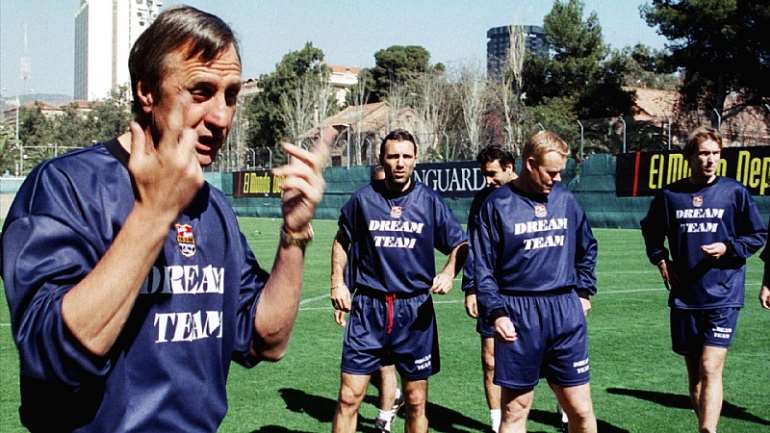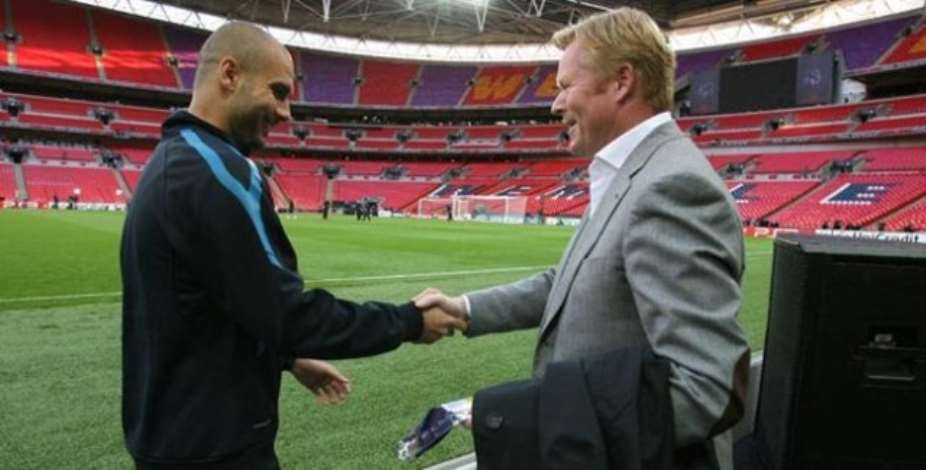Even Ronald Koeman was somewhat taken aback - and impressed.
It was early 1990 and Barcelona manager Johan Cruyff had instructed the Dutch sweeper to take a new young academy graduate under his wing, and teach him a bit. Koeman was always willing to do so on the provision that a kid was actually interested and willing to learn, but he was surprised at just how interested this one was.
A teenage Pep Guardiola, who was now Koeman’s roommate, immediately began peppering him with very pointed and sophisticated questions. These weren’t general queries about the team’s style, or little things he should do in his position. These were very forensic discussions about the finest details of the philosophy, what really made it work.
“He wanted to know everything,” Koeman has said. “More than any other player, he wanted to know about one-touch football, about positional play, one touch in small spaces. He loved the way Cruyff wanted to play with Barcelona.”
So, if Saturday’s match between Manchester City and Everton comes down to those fine details 26 years on, it will be all too fitting.
It is also so fitting that, after a week when Guardiola has discussed Cruyff so much, his very next match is against the figure who he most talked about Cruyff with. Koeman and Guardiola went on to room together for years and, in this case, an older figure’s joke that he taught a junior colleague everything they know is some way true.
This is actually their first match as opposing managers but may well be the most deeply symbolic of all the meetings of the Cruyff-Barcelona disciples. That is not just because they have their own individual history together, or that they represent both sides of Cruyff as a Dutchman and a Catalan. All that only strengthens the link.
Because, when Cruyff first arrived at Camp Nou as manager in 1988, he specifically requested his former centre-half at Ajax as a signing, for the way Koeman’s distinctive play from the back could start moves. Guardiola was eventually put just in front of him, but part of his game was to instinctively understand to drop back when Koeman was surging forward, making their off-pitch relationship all the more important. The two were the physical foundations of Cruyff’s fine-tuned version of Total Football for the early 90s, the on-pitch starting points that ensured the philosophy was applied. It brought Barca all the way to the 1992 Champions League final - a competition a club of their size had remarkably never won.

In the 111th minute of extra-time of that match against Sampdoria, the Catalans were awarded a free-kick just outside the box, and an assertive Guardiola strode up the Wembley pitch expecting to take it. He had already come a long way, but not quite far enough to command a moment as pivotal as that; for a role owned by someone else. Hristo Stoichkov made that all too clear to Guardiola by pushing him away, and set-piece expert Koeman then so clearly put the ball into the corner of the net by powerfully curling it past Gianluca Piagluca.
Barcelona had finally won their first European Cup, Cruyff’s first and most important big signing had given his team their crowning moment, and Koeman himself had scored what is still regarded as the most important goal in the club’s entire history.
It was not just that they had finally won the most prestigious prize in football, and one so associated with Real Madrid. It was that victory so further vindicated Cruyff’s approach, one that was to then be so deeply ingrained in the club and ultimately take them past their rivals.
Koeman’s classic Adidas-made black right boot from that night is now a centre-piece in the Camp Nou museum but, had things gone a little differently, it could have been Guardiola’s Diadora there instead.
Guardiola still had an important status in the side as a local Catalan lad who had famously been a ball-boy in the doomed 1985-86 run to the European Cup final, though, and went on to offer a moment that became almost as famous as Koeman’s goal. When it came to present the cup, the then 21-year-old did so by stating the words “Ja la teniu aqui” – “here you have it”. Guardiola was deliberately echoing the words of Catalan president Josep Tarradellas. On returning from exile in 1977 after General Franco’s death, he had announced “Ja soc aqui” - ‘Here I am’.
Guardiola felt the identity of the club so deeply, of course, that he would take their new self-determining football philosophy even further. He would hone and develop Cruyff’s ideals, to the point Barcelona moved onto another level when he became manager in 2008.

The student had become the master, and come to master the school of thought. His initial tutor has always remained a very proud Cruyff disciple, but Koeman never quite had Guardiola’s evangelism. The Everton manager has always been more pragmatic about the principles, and willing to adapt them if a side proved unable to immediately adopt them.
He made that clear immediately after his first Everton game against Tottenham Hotspur. “I believe in different systems for the players, which makes it difficult for the opponents to know what to expect. We have players who can play different systems. We prefer to play 4-3-3 but sometimes tactic-wise, you can change.”
There were also hints at a slightly different outlook when he discussed that 1992 Barcelona team with the Daily Mail back in 2011.
“We also pushed right up in every game,” Koeman told Rob Draper. “It created fantastic games to watch but we were also punished. We left big spaces behind our defence, but Cruyff said we would win the majority of our games and he was right.”
Koeman, however, has never been quite so willing to take that risk or that leap of faith. It feels even more pointed now that he has so consciously made Everton more solid after Roberto Martinez, and that he likes his backline to first and foremost be defenders rather than ball-players.

Seamus Coleman referenced this recently: “[Roberto] liked his full backs getting high and unfortunately at times we conceded too many goals. This manager wants us to be solid first and then build on that with the quality attacking players.”
There is also an argument, however, that difference explains why he hasn’t been anywhere near as successful as Guardiola. To fully implement a philosophy requires that Cruyff-like faith and a lot of investment, but the end result - if a manager is good enough - is that a team more fully understands each other and are more integrated, naturally leading to higher level of play. They can do things faster, and in more devastating a manner.
Koeman has never had the intensity for it that Guardiola does, but that perhaps explains why he has had a more nomadic and less invested career. He is not building legacies at clubs - but he does build good teams.
It may well be good enough to beat City on Saturday. It could come down to those fine details discussed almost three decades ago. Or, Guardiola might again take him aback.





 Lay KPMG audit report on SML-GRA contract before Parliament – Isaac Adongo tells...
Lay KPMG audit report on SML-GRA contract before Parliament – Isaac Adongo tells...
 Supervisor remanded for stabbing businessman with broken bottle and screwdriver
Supervisor remanded for stabbing businessman with broken bottle and screwdriver
 NDC watching EC and NPP closely on Returning Officer recruitment — Omane Boamah
NDC watching EC and NPP closely on Returning Officer recruitment — Omane Boamah
 Your decision to contest for president again is pathetic – Annoh-Dompreh blasts ...
Your decision to contest for president again is pathetic – Annoh-Dompreh blasts ...
 Election 2024: Security agencies ready to keep peace and secure the country — IG...
Election 2024: Security agencies ready to keep peace and secure the country — IG...
 People no longer place value in public basic schools; new uniforms, painting wil...
People no longer place value in public basic schools; new uniforms, painting wil...
 'Comedian' Paul Adom Otchere needs help – Sulemana Braimah
'Comedian' Paul Adom Otchere needs help – Sulemana Braimah
 Ejisu by-election: Only 33% of voters can be swayed by inducement — Global InfoA...
Ejisu by-election: Only 33% of voters can be swayed by inducement — Global InfoA...
 Minority will expose the beneficial owners of SML, recover funds paid to company...
Minority will expose the beneficial owners of SML, recover funds paid to company...
 Prof. Opoku-Agyemang has ‘decapitated’ the NPP’s strategies; don’t take them ser...
Prof. Opoku-Agyemang has ‘decapitated’ the NPP’s strategies; don’t take them ser...
